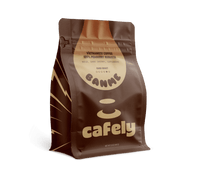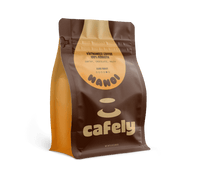Blonde roast coffee is renowned for its lighter, more delicate flavor than medium and dark roasts. It undergoes a minimal roasting process, resulting in a bright flavor profile that encourages the bean’s unique characteristics to shine bright.
Blonde roast coffee beans are popping up all over the place — from international chain coffee shops to specialty cafes and online stores. If you haven’t tried the light, fruity roast yet, you’re missing out!
In this article, we’ll discuss the unique characteristics of blonde roast coffee, the best way to brew it, and the surprising health benefits you may get from just one cup.
What is Blonde Roast Coffee?
Blonde roast coffee is a type of light roast coffee that's been minimally roasted. Roast level is a spectrum, and what each coffee roaster refers to as "blonde roast" can differ.
Light roasts are roasted for a shorter time than medium or dark roasts. This gives them a more golden color and acidic taste.
Blonde roast coffee beans are usually removed from the roaster just before or immediately after the first crack.
The name “blonde coffee” comes from the distinctive golden (or blonde) color the coffee beans turn after the short roasting process.
Some people think the color looks more cinnamon than golden and, therefore, refer to the same coffee as "cinnamon roast." But despite what the name may suggest, cinnamon roast doesn't actually taste like cinnamon.
Flavor Characteristics of Blonde Roast Coffee
Blonde roast coffee goes through minimal roasting. Because of this, a coffee made with blonde beans has a higher acidity, lighter body, and a brighter flavor profile than a coffee made with medium or dark beans.
The shorter roasting process produces less oil, allowing the bean’s unique characteristics to shine.
Exact flavor characteristics vary according to the type of coffee bean, its origin, and even the specific crop. But in general, blonde roast coffee has citrusy flavors with subtle floral, fruity notes.
The fruity flavor of Arabica beans makes it the most ideal to use for blonde roast coffee, but there are plenty of great alternatives available, too. Look online and in specialty stores, and you'll find single-origin coffees and blends from Central America and Africa that make a great blonde roast.
Blonde roast coffee is often confused with white roast coffee, but the two are very different.
Blonde Roast Coffee vs. White Roast Coffee:

Blonde Roast Brewing Methods
Blonde roast coffee is incredibly versatile and works for every type of brewing method.
With that said, there are a few brewing methods that do a better job of highlighting the best parts of its natural flavor profile without emphasizing the negatives. Brewing methods that emphasize control over water temperature and extraction times, as well as minimizing overly acidic coffees, tend to work best with blonde roast coffee beans.
Top 4 recommended brewing techniques for blonde roast coffee:
- Pour-Over brew (Hario V60) — This is the most popular way of brewing blonde roast. It's quick and simple and brings out the light, fruity qualities of the roast.
- Americano coffee — If you enjoy black coffee, try blonde roast as an Americano without any cream or sweetener. This style of coffee invites you to fully enjoy the unique flavor profile of the delicate beans.
- Espresso-Based Drinks — Espresso-based drinks, like cappuccinos and lattes, are great if you want to appreciate the unique flavors of blonde roast without drinking your coffee black.
- Cold Brew — The slow extraction process reduces the acidity of blonde roast coffee while allowing the nuttiness to shine through.
Benefits of Blonde Roast Coffee
The incredible flavor isn’t the only benefit of blonde roast coffee. This trendy roast is also higher in polyphenols (a type of antioxidant) than darker roasts. This means blonde roast coffee may be better at supporting longevity than other varieties.
The caffeine levels are also slightly higher in blonde roast coffee compared to medium or dark roasts.
This is because blonde roast has been exposed to less heat — causing less of the caffeine to degrade during the process. However, the difference is only subtle.
A cup of blonde roast coffee typically only delivers 1-5 mg of caffeine more than a cup made with medium or dark roast.
Blonde Roast Coffee Food Pairings
You’ve probably heard of wine pairings, but have you ever heard of coffee pairings? The delicate flavors and unique aromas make it perfect for pairing with food for an amazing gastronomic experience.
Blonde roast coffee’s acidic, bright, and fruity flavor profile makes it perfect for pairing with:
- Buttery pastries, like croissants and pains au chocolate
- Rich fruits, like avocados and bananas
- Zesty baked goods, like lemon cake and orange cookies
- Smooth ice cream flavors, like vanilla and caramel
Try pairing a cup of blonde roast coffee with one of the above suggestions. Have a sip of coffee and then a bite of your food. Notice how the food influences the flavor of the coffee and vice versa.
FAQs: Blonde Roast Coffee
Here are 10 of the most common blonde roast coffee questions we get asked, including where to buy the best coffee beans.
1. What makes blonde roast coffee different from other light roasts?
The main difference between blonde roast coffee and other light roasts is the roasting time. Blonde coffee (also known as cinnamon coffee) has gone through the least roasting time.
It’s removed from the roaster just before or immediately after the first crack. Because of this, it has a lighter color and a milder flavor profile compared to other light roasts.
2. Can blonde roast coffee be used for espresso?
Yes, blonde roast coffee can be used for espresso. When you make an espresso using this type of bean, you get a lighter, fruitier, and more acidic shot compared to darker roasts. Blonde roast coffee works great for any espresso-based drinks — cappuccinos, lattes, macchiatos, etc.
3. Is blonde roast coffee more acidic than dark roast?
Yes, blonde roast coffee retains more acidity than dark roast coffee. This is because heat breaks down the acidity during the roasting process — the less time coffee beans are roasted, the more acidic the flavor will be.
The acidity in blonde roast coffee contributes to its bright, vibrant, and fruity flavor, which many people love.
4. How should I grind blonde roast coffee for optimal flavor?

A medium-fine grind is best for blonde roast coffee. This grind slows down the water flow, creating more time for the complex flavors to be fully extracted.
Blonde roasted beans are denser than medium and darker roasts, so they can be tough on your grinder. If you’re going to grind your own blonde beans, it’s a good idea to invest in a high-quality burr grinder.
5. Where can I buy high-quality blonde roast coffee?
There are many specialty coffee retailers and online stores that offer high-quality blonde roast coffee beans. This roast is so popular that chains like Starbucks even sell it. We suggest you look for brands that source their beans ethically.
6. Does blonde roast coffee have more caffeine than dark roast?
Yes, blonde roast coffee does have more caffeine — scoop for scoop. This is because blonde roast coffee beans are denser than medium and light roast. So, one scoop of blonde roast coffee beans will have more caffeine than one scoop of dark roast coffee beans.
However, because of the higher caffeine content, you need a smaller volume of blonde roast coffee than you do medium or dark roast coffee. So, a cup of coffee made with blonde roast will have roughly the same amount of caffeine as a cup made with medium or dark roast.
The difference between blonde roast, medium roast, and dark roast is only 1-5 mg of caffeine per cup.
7. What is the best way to store blonde roast coffee?
You should store blonde roast coffee the same way you store any other kind of coffee bean. It will stay freshest inside an airtight container away from direct sunlight and moisture.
Whole coffee beans will stay fresh this way for up to three months. Ground coffee will only last around two weeks.
8. Can I make cold brew with blonde roast coffee?
Absolutely! Blonde roast coffee can make a refreshing cold brew with a lighter and smoother taste. If you enjoy regular blonde roast coffee, you’ll love the cold brew version. If you prefer a darker roast, you’re best off sticking to dark roast beans to make your cold brew.
9. What are the best pairings for blonde roast coffee?
Blonde roast coffee generally pairs well with anything that’s sweet, buttery, or citrusy. Light pastries like croissants, fruits like avocado, zingy baked goods like lemon cake, and even vanilla ice cream complement blonde roast coffee wonderfully.
10. Why is blonde roast coffee becoming more popular?
Blonde roast coffee’s unique flavor profile is what makes it so popular. It’s milder, more vibrant, and more acidic than medium and dark roasts. It’s an excellent option for people who think they don’t like coffee.
Blonde roast coffee isn’t just popular in coffee shops — it’s popular among home brewers, too. Blonde beans work great for almost any kind of coffee (cold brew, iced coffee, drip coffee, espresso, etc) so you can buy a single bag of beans and use it in many different ways.












